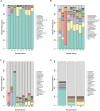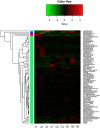The Dynamic Distribution of Small-Tail Han Sheep Microbiota across Different Intestinal Segments
- PMID: 29445360
- PMCID: PMC5797768
- DOI: 10.3389/fmicb.2018.00032
The Dynamic Distribution of Small-Tail Han Sheep Microbiota across Different Intestinal Segments
Abstract
The sheep intestinal tract is characterized by a diverse microbial ecosystem that is vital for the host to digest diet material. The importance of gut microbiota (GM) of animals has also been widely acknowledged because of its pivotal roles in the health and well-being of animals. However, there are no relevant studies on GM of small-tail Han sheep, a superior mutton variety domestic in China. In this study, the structure and distribution of gut microflora were studied by high-throughput sequencing technology. Results showed a significant difference between jejunum and cecum, jejunum, and rectum. Meanwhile, the cecum and rectum not only display higher species richness but also exhibit higher similarity of the bacterial diversity than that of the jejunum based on the results of abundance-based coverage estimator (ACE), Chao1, and Shannon indexes. Firmicutes and Bacteroidetes were the predominant phyla in cecum and rectum, while higher relative abundances of Firmicutes and Cyanobacteria were observed in jejunum. At the genus level, Bacteroidetes, Ruminococcus, Lactobacillus, Flavonifractor, and Clostridium were the dominant genera in the cecum and rectum. An obvious dynamic distribution of Lactobacillus is continuously decreasing from the jejunum to the cecum, then to the rectum, whereas the result of Bacteroides is completely inverse. In addition, this study also found many kinds of bacteria associated with the production of volatile fatty acids (VFA) colonized in the large intestine. This study is the first to investigate the distribution of intestinal flora in small-tail Han sheep. The findings provide an important indication for diagnosis and treatment of intestinal diseases in small-tail Han sheep, as well as offer a direction for the development of intestinal microecological preparations.
Keywords: dynamic distribution; gut microbiota; high-throughput sequencing; small-tail Han sheep; volatile fatty acids.
Figures





Similar articles
-
Comparison Between the Gut Microbiota in Different Gastrointestinal Segments of Large-Tailed Han and Small-Tailed Han Sheep Breeds with High-Throughput Sequencing.Indian J Microbiol. 2020 Dec;60(4):436-450. doi: 10.1007/s12088-020-00885-4. Epub 2020 May 25. Indian J Microbiol. 2020. PMID: 33087993 Free PMC article.
-
Characterization of the bacterial microbiota across the different intestinal segments of the Qinghai semi-fine wool sheep on the Qinghai-Tibetan Plateau.Anim Biosci. 2021 Dec;34(12):1921-1929. doi: 10.5713/ab.20.0809. Epub 2021 Jun 23. Anim Biosci. 2021. PMID: 34237935 Free PMC article.
-
Distribution of bacteria in different regions of the small intestine with Zanthoxylum bungeanum essential oil supplement in small-tailed Han sheep.Front Microbiol. 2022 Dec 23;13:1062077. doi: 10.3389/fmicb.2022.1062077. eCollection 2022. Front Microbiol. 2022. PMID: 36619991 Free PMC article.
-
Characterization of the microbial communities along the gastrointestinal tract of sheep by 454 pyrosequencing analysis.Asian-Australas J Anim Sci. 2017 Jan;30(1):100-110. doi: 10.5713/ajas.16.0166. Epub 2016 Jun 30. Asian-Australas J Anim Sci. 2017. PMID: 27383798 Free PMC article.
-
Distribution of gut microbiota across intestinal segments and their impact on human physiological and pathological processes.Cell Biosci. 2025 Apr 16;15(1):47. doi: 10.1186/s13578-025-01385-y. Cell Biosci. 2025. PMID: 40241220 Free PMC article. Review.
Cited by
-
Metabarcoding analysis of the microbiota in flocks naturally infected by Coxiella burnetii: First description of the global microbiota in domestic small ruminants.One Health. 2025 Feb 19;20:100996. doi: 10.1016/j.onehlt.2025.100996. eCollection 2025 Jun. One Health. 2025. PMID: 40093541 Free PMC article.
-
Metagenomic insights into the effects of Chive seed flavonoid on intestinal fermentation, morphology, and microbiota composition in sheep.Front Microbiol. 2025 Jun 13;16:1590400. doi: 10.3389/fmicb.2025.1590400. eCollection 2025. Front Microbiol. 2025. PMID: 40584035 Free PMC article.
-
Nitrogen Utilization and Ruminal Microbiota of Hu Lambs in Response to Varying Dietary Metabolizable Protein Levels.Animals (Basel). 2025 Jul 21;15(14):2147. doi: 10.3390/ani15142147. Animals (Basel). 2025. PMID: 40723609 Free PMC article.
-
Association between body weight and distal gut microbes in Hainan black goats at weaning age.Front Microbiol. 2022 Sep 16;13:951473. doi: 10.3389/fmicb.2022.951473. eCollection 2022. Front Microbiol. 2022. PMID: 36187995 Free PMC article.
-
Research on the Gut Microbiota of Hainan Black Goat.Animals (Basel). 2022 Nov 13;12(22):3129. doi: 10.3390/ani12223129. Animals (Basel). 2022. PMID: 36428357 Free PMC article.
References
LinkOut - more resources
Full Text Sources
Other Literature Sources
Miscellaneous

